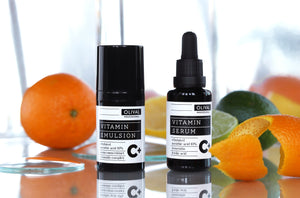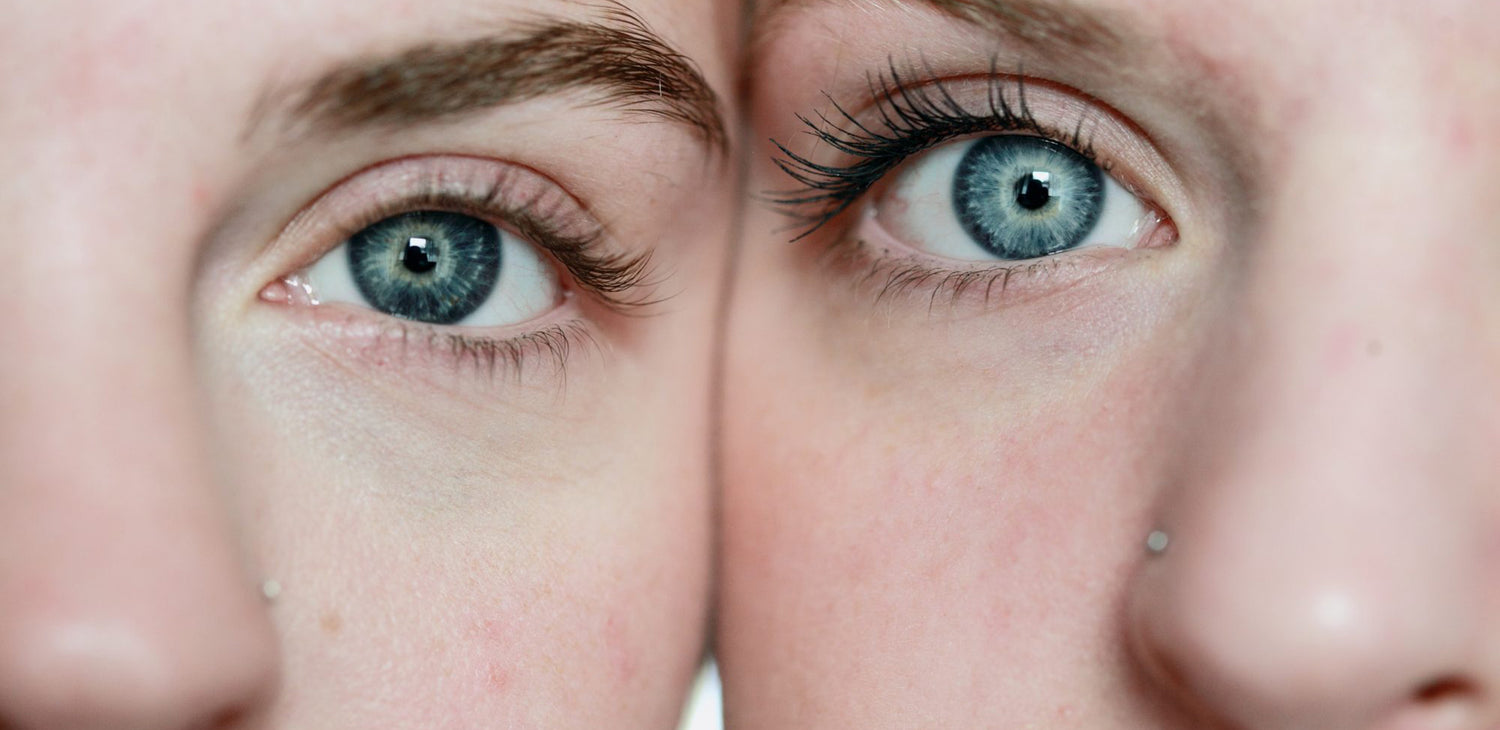Choosing a retinoid product is not an easy task. Questions often arise about strength, frequency of use, and how the skin will react. As an answer to these concerns, a potent, powerful, and highly concentrated product has arrived – meet the Vitamin Serum RA!
A powerful concentration of the most interesting retinoid today
Vitamin Serum RA contains retinaldehyde (also known as retinal) , a derivative of vitamin A and a natural precursor of retinoic acid.
We can also call it the "stronger brother" of retinol, since it is located right next to retinoic acid in the conversion chain, unlike the more well-known and weaker retinol.
Retinaldehyde is a form of retinoid that shows extremely good action against premature skin aging and skin irregularities in the form of acne and pimples (especially in adulthood) . In vitro tests have shown that it is the only one in the group of retinoids that, in topical application, provides antibacterial action against gram-positive bacteria such as S. aeureus , Micrococcus spp. or C. acnes , or agents associated with the development of inflammatory conditions such as acne. [1]

We can freely call retinaldehyde an "all-rounder" because its effect on the skin has been thoroughly tested and is multiple, and the conversion of retinaldehyde into retinoic acid enables a more controlled delivery of retinoic acid to the skin, thus milder negative effects (irritant potential) compared to other retinoids. [2] During the 4-month trial, the effect of retinaldehyde in a concentration of 0.05% was also observed in 32 test subjects with signs of mild or moderate photoaging. At the end of the observed period, a significant shift in skin texture was noted, with very few unwanted effects. [3]
The serum contains 0.1% pure encapsulated retinaldehyde, which is a high concentration and makes the product very potent.
"All-rounder" from which everyone benefits
We could divide the action of the Vitamin Serum RA into 4 main effects:
- Removes and prevents irregularities
- It balances sebum secretion
- Reduces the visibility of hyperpigmentation
- It evens out the complexion and slows down photoaging
In addition to retinaldehyde (retinal), the serum "owes" its extremely positive effects on the skin to a carefully designed list of ingredients for effective synergistic action. It contains astaxanthin, an extremely strong antioxidant of natural origin that prevents photodamage on the skin , and in synergy with retinoid acts against free radicals and visible hyperpigmentation. In addition to astaxanthin, the formulation also contains a complex of ceramides, bisabolol and allantoin, which additionally alleviate the irritating potential of retinoids.
Antioxidant effect up to 100 times stronger than vitamin E
Astaxanthin is one of the most powerful natural antioxidants in general, and it belongs to carotenoids. It is 10 to 100 times stronger than beta-carotene and lycopene, as well as vitamins C and E. It has a characteristic bright orange color, which, along with retinal, is responsible for the unique color of Vitamin Serum RA . The unique molecular structure of astaxanthin protects the skin from photodamage caused by exposure to UV rays and effectively stimulates its renewal, revealing healthy and shiny skin. It works against hyperpigmentation by suppressing the production of melanin in the skin and controlling its deposition. Astaxanthin also increases the skin's ability to retain much-needed moisture, up to 40% . It strengthens the elasticity of tissues, firmness and fullness of the skin and contributes to the overall refreshed, uniform and shiny complexion. In synergy with retinaldehyde, it works against free radicals and visible hyperpigmentation, as well as treatment spots.

Ceramides, bisabolol, allantoin, glycerin...
Vitamin Serum RA contains both bioidentical ceramides and their precursors that correct damage to the hydrolipid barrier of the skin ( stratum corneum ), stimulate the synthesis of skin lipids and stimulate the natural property of self-regulation of hydration levels, which leads to stronger and more resistant skin, but also long-term balancing of increased sebum secretion as is not rare occurrences in dehydrated skin. The formulation is rounded off by iconic and inevitable nourishing ingredients – bisabolol, allantoin and aloe vera.
Bisabolol is an extremely soothing, anti-inflammatory and antimicrobial ingredient that is ideal for skin with a damaged hydrolipidic barrier, prone to irritation . It is known for increasing the power of absorption of active substances and ingredients into the skin, especially antioxidants and potent active ingredients such as retinaldehyde. It is very nourishing, and provides the skin with a possible effect against dyspigmentation. Allantoin is also one of the most well-known hydrating and regenerating substances in preparative cosmetics. It acts as a kind of modulator of inflammatory reactions and processes in the skin, stimulating renewal and healing.
Who is the serum intended for?
Vitamin Serum RA is intended for everyone who wants to introduce retinaldehyde into their care routine, as well as more experienced retinoid users whose skin needs something more than retinyl palmitate and retinol , and still do not want to resort to retinoids available only by prescription.
It is recommended to use on:
- skins "accustomed" to milder forms of retinoids, i.e. people who want to switch to more specific care
- oily and mixed skin prone to clogged pores, acne and pimples
- balanced skin with hyperpigmentation, wrinkles and fine lines
- thin, resistant skin damaged by the sun that needs renewal (with especially careful and slow introduction)
How to use RA Vitamin Serum
Introduce into the routine in the evening, to begin with on a clean dry face . Apply an amount of 2 pomegranate seeds to the entire face, avoiding the eye area, then apply a moisturizer and/or oil without other active substances (without vitamin C, other retinoids, acids - hyaluronic acid and peptides are an exception). Use two to three times a week, monitor the skin, then gradually increase the use depending on needs . With more resistant skin, it is possible to use it every day, even with application after tonic and moisturizing serum (based on hyaluronic acid, for example Hyaluron Hydrator 4H ). In the case of skin prone to irritation and when retinoids are first introduced into skin care, it is also possible to apply them using the buffering technique (first a neutral nourishing cream, then a serum, then cream and/or oil again). If there is any doubt about the introduction of this serum, we recommend contacting you for a personalized recommendation and care routine , as well as a mandatory patch test on the forearm lasting 48 hours.

What to (potentially) expect during use
Retinoids by themselves accelerate cell turnover and can cause temporary irritation (depending on the skin itself) until it gets used to the introduction of this active substance. In order to minimize this irritating potential, the formulation also contains ceramides, bisabolol and allantoin, which restore and strengthen the skin's protective barrier, contribute to elasticity and firmness, and reduce moisture loss by strengthening the "ability" of the skin to retain it in its layers, as well as aloe vera and glycerin for an extra dose of hydration. They have a synergistic effect on soothing the skin, preventing peeling and faster adaptation to the introduction of retinoids into the routine.
As they speed up cell turnover, they speed up the process of discarding dead cells and the exit of closed comedones on the skin. Because of this, a phase of skin cleansing is possible in which closed comedones that were under the surface will come to the surface. The active substance in the serum, retinaldehyde, works by helping to "extract" them and then heal them, and at the same time prevents new inflammations and treatment spots. This phase is individual (it may or may not happen), it is temporary and transient.
What you must pay attention to
Vitamin Serum RA is used only in the evening and its use during pregnancy is not recommended. It should not be used in parallel (in the same routine) with acids, other retinoids with strong active substances (for example, high concentrations of ascorbic acid) and peelings (at least not at first)! Temporary redness and a slight burning sensation are possible, which is temporary and fleeting. If it continues for a long time or increases, it is necessary to stop the use. Not for sensitive, damaged skin, skin with chronic conditions and extremely prone to irritation. A high protection factor against the sun during the day is necessary when using this product. We suggest Professional face fluid SPF 30 or cream SPF 50 , i.e. products that easily replace the daily cream, and provide additional care with niacinamide and coenzyme Q10. The product does not contain added fragrance, and it has a characteristic orange color that is of natural origin (astaxanthin and retinal in combination) and can vary from a weaker to a stronger shade.
------------------
[1] M Pechère 1, L Germanier, G Siegenthaler, JC Pechère, JH Saurat. The antibacterial activity of topical retinoids: the case of retinaldehyde. Dermatology 205.2 (2002): 153-158. https://pubmed.ncbi.nlm.nih.gov/12218231/ accessed 9/24/2020.
[2] Jean Hilaire Saurat, Liliane Didierjean, Elisabeth Masgrau, Pierre A Piletta, Stefano Jaconi, Dominique Chatellard-Gruaz, Dagmar Gumowski, Isabelle Masouyé, Denis Salomon, Georges Siegenthaler. Topical Retinaldehyde on Human Skin: Biological Effects and Tolerance. Journal of Investigative Dermatology Volume 103:6 (1994) 770-774. https://www.sciencedirect.com/science/article/pii/S0022202X94958181 accessed 9/24/2020.
[3] Ochando N, LaGarde JM, Couval E, et al. Evaluation clinique et paraclinique des effets du retinaldéhyde topical dans le photovieillissement cutané Nouv Dermatol. 13 (1994) 525–35. https://core.ac.uk/download/pdf/20637925.pdf accessed 24/09/2020.




